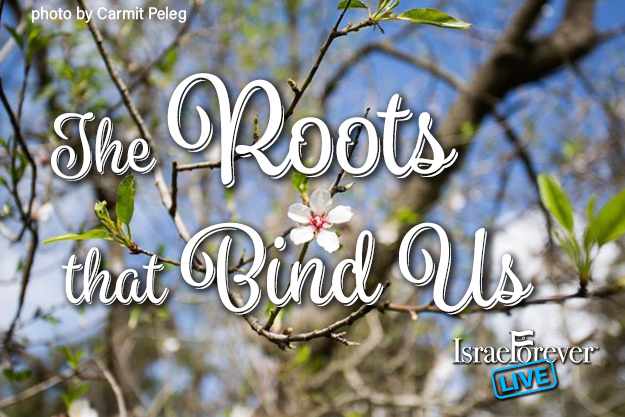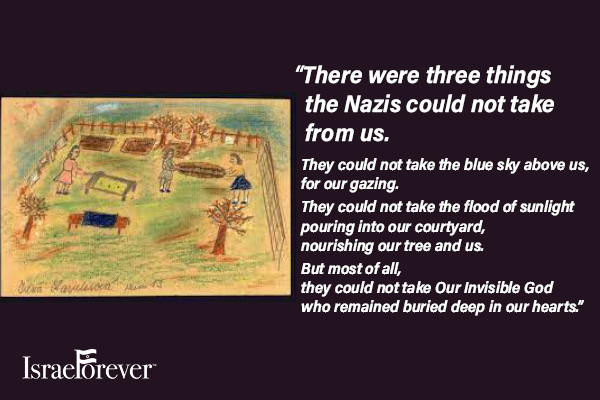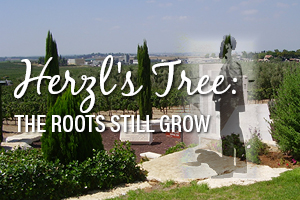From Roots to Roots: Tu B'Shevat from Terezin to Today

In 1943, a maple sapling was smuggled into the ghetto of Terezin. A young girl who had helped plant this tree wrote:
There were three things the Nazis could not take from us.They could not take the blue sky above us, for our gazing.They could not take the flood of sunlight pouring into our courtyard,nourishing our tree and us.But most of all, they could not take Our Invisible Godwho remained buried deep in our hearts.
Forty miles outside of Prague, at the walled fortress of Terezin. In the autumn of 1941, the Nazis set up a ghetto which was administered by the SS, guarded by Czech gendarmes, and run internally by a Jewish Council. While Terezin appeared similar to other ghettos, it was in fact a unique experiment for testing the Nazi agenda for the isolation, persecution and elimination of the Jews of Europe while being used simultaneously as the “model ghetto” for visits by the International Red Cross, continuously deceiving them to believing the ghetto was nothing more than an important element to protecting the Nazi goal of a society “clean” from unwanted elements.
Overcrowding, hunger, disease, and despair dictated daily life. While deportations were a constant reality, the volunteer teachers devoted themselves to providing meaningful and even joyful moments for the children and families. As in many ghettos, the Jews in Terezin made every effort to continue educational and cultural activities. Famous artists and scholars taught lessons to the children and encouraged them to read, draw and to write - from which emerged one of the most famous and precious artistic expressions was composed– the poem “I Never Saw Another Butterfly” by Pavel Friedmann. The children put on plays and wrote a newspaper. Clandestine lessons flourished, including Jewish heritage and religion.

Zionist youth movement leaders inspired and taught the vastly secular audience about pride in their own Jewish identity. As such, efforts to retain their humanity were continuously conceived - from arts to newspapers to operas - as a continued flow of humanity came and left Terezin, swelling to more than 50,000 Jews who lived in constant dread of deportation to the East towards the Nazi exterminations centers in Poland. According to statistics: 141,000 people passed through; 33,456 died in the ghetto, 88,202 were deported; 16,832 were liberated in 1945.
Irma Lauscher was one of the volunteer teachers in Terezin, sharing her love and appreciation for Jewish traditions and holidays. In January 1943, Irma decided to lift the spirits of the children by organizing a celebration of the ancestral holiday of Tu B’Shevat, the New Year of the trees of the Land of Israel. She bribed one of the Czech guards to smuggle a tree sapling into the ghetto, carried inside his boot and nurtured to life by the children imprisoned there. She organized a ceremony of dancing and singing with the children of the ghetto, and together they planted the tree, sharing their water rations. The children nurtured their tree, wrote poetry about it, and were inspired by it. They called it the Etz Hayim-the Tree of Life.
Of the 15,000 children who were imprisoned in Terezin, only some 150 survived. After the war, Ela Weissberger was among the handful of children who returned and found the tree still alive. They carefully transplanted the tree next to the crematorium and dedicated a headstone with the prophetic words of Isaiah: “As the days of a tree shall be the days of my people!”
A poem was written dedicated to this Etz Hayim, which grew to be over 60 feet tall:
I returned home here to Theresienstadt.I stand guard here on this rise of this hillby this tree that moves slightlyas it creaks the names of the childrenslowly to me.. every night.We watch over this place. This tree and I.We watch over the children of Theresienstadt.We still hear their songs.Shhh-hh-h.. do you hear?
While in Terezin, Ela performed in Brundibar, a children’s opera that has been performed worldwide, often with Ela present as a special guest. In 2001, on Tu B’Shevat, Ela and the Cincinnati Opera’s cast planted a commemorative maple sapling on the grounds of Hebrew Union College in honor of the children of Terezin. When Ela Weissberger discovered that floods destroyed a lot of the Czech countryside and uprooted ‘the children’s tree’ at Terezin. She remembered the seeds that the HUC student had brought back from Terezin and, full of hope, she asked if it was possible that any of the seeds were still viable. Miraculously, the seeds are growing in an incubator at the Cincinnati Krohn’s Conservatory and continue to give forth life.
Excerpted from https://www.holocaustandhumanity.org/education/online-exhibits/faith/tu-bishvat/
Carry on the legacy of the Etz Hayim Tree of Terezin and plant Israel at home with this special Celebration of the Land Tu B’Shevat Seder by The Israel Forever Foundation. With readings, activities, recipes and more, bring your own Tu B’shevat experience to life as a sign of our own renewal and continuity!









